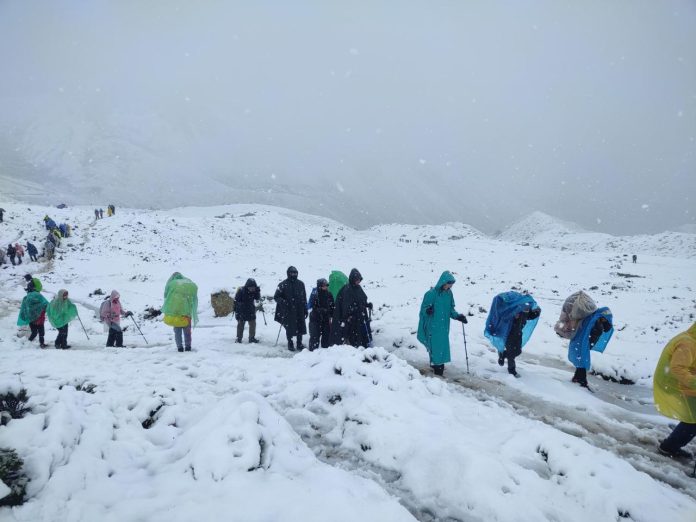Nepal, with its stunning Himalayan landscapes, rich cultural heritage, and adventure-friendly atmosphere, is a magnet for tourists worldwide, especially trekkers and mountaineers.
Yet, as tourism continues to grow, so do the challenges that impact both visitors and locals.
Issues like bumpy access roads, littering along popular trails, overtourism, climate change effects, and inconsistent policies between local and central governments are among the pressing concerns that need addressing to ensure sustainable tourism in Nepal.
In this blog, we’ll explore each of these issues, along with suggestions to mitigate them for a more sustainable and rewarding tourism experience.
Poor Road Infrastructure Leading to Trailheads
One of the challenges tourists face even before setting foot on Nepal’s trails is the journey to get there.
For instance, the road to Machha Khola—the trailhead for the Manaslu Circuit Trek—remains unpaved and rugged, with frequent potholes, narrow sections, and landslide-prone areas.
These roads become even more hazardous during the monsoon season when landslides and flooding are common. As a result, trekkers face uncomfortable and lengthy journeys on bumpy roads, which can put a damper on the trekking experience from the start.
Moreover, poor road infrastructure complicates the logistics for local communities, increasing transportation costs for both supplies and visitors.
Improving the infrastructure leading to popular trekking trailheads is essential to ensure a safer and more accessible travel experience.
Collaborative efforts between the government and local authorities could lead to the construction and consistent maintenance of access roads, including guardrails and landslide prevention measures.
Enhanced road infrastructure would not only make trekking areas more accessible but also support local economies by facilitating the movement of goods and services, benefiting both visitors and residents.
Littering and Waste Management on Trails
With the rise in tourism, littering along trekking trails has become a prominent issue in Nepal’s popular trekking regions, especially in Everest and Annapurna.
Discarded plastic bottles, food wrappers, and other waste items left by trekkers create an eyesore and pose serious environmental risks. In these remote regions, waste management facilities are minimal, and trash is often left uncollected, polluting local ecosystems and impacting water sources.
Littering also detracts from the natural beauty of Nepal’s landscapes, which is a key draw for visitors in the first place.
To tackle littering, Nepal can encourage “pack-in, pack-out” policies where trekkers are required to take their waste back with them. Installing designated trash collection points at regular intervals along popular trails and recycling facilities near trailheads would also help with waste disposal.
Educational campaigns emphasizing the importance of preserving Nepal’s pristine environments, along with guidelines provided by tour operators, would increase awareness among trekkers and help foster more responsible tourism practices.
Overtourism in Popular Trekking Regions
Popular trekking regions like Everest Base Camp and the Annapurna Circuit often experience overtourism during peak seasons, leading to crowded trails, strained resources, and a diminished experience for visitors.
High tourist volumes can impact local resources like water, fuel, and accommodation capacity, creating tension with local communities.
The overwhelming concentration of tourists in these areas also means that other, less-known regions with equal beauty and appeal remain underutilized, resulting in an unbalanced distribution of tourism benefits across the country.
Diversifying trekking options by promoting alternative routes like the Manaslu Circuit or the Khopra Danda Trek can alleviate the pressure on more popular areas.
Implementing caps on daily or seasonal visitor numbers in high-traffic regions and redistributing permits across alternative trails can help manage the flow of visitors more sustainably.
Investment in promoting lesser-known routes would also encourage tourists to explore new areas, benefitting the local economy in regions that typically see less tourist activity.
Unpredictable Weather Patterns and Climate Change
Global warming and climate change have led to increasingly erratic weather patterns in Nepal, complicating trekking and mountaineering activities. Even during what were once predictable trekking seasons, trekkers now face unexpected rain, landslides, or snowfalls.
Unpredictable weather conditions can lead to flight cancellations, route closures, and an elevated risk of accidents, affecting the safety and overall experience of visitors. Moreover, climate change threatens Nepal’s glaciers and biodiversity, disrupting delicate ecosystems and endangering the long-term sustainability of trekking routes.
Providing up-to-date weather information, improving forecasting systems, and educating trekkers on the impacts of climate change can enhance safety and preparedness.
Trekking companies can work with local authorities to ensure guides are trained in handling weather-related emergencies and educating trekkers about climate-related risks.
Encouraging eco-friendly tourism practices, like minimizing waste and opting for low-impact travel, can help Nepal contribute to global efforts in combating climate change, preserving its mountains and trails for future generations.
Inconsistent Policies Between Local and Central Governments
Tourism policies and fees often differ between local and central government authorities, resulting in inconsistencies that can confuse tourists and trekking operators alike.
Different fee structures, permit requirements, and management practices can create logistical issues, increasing costs and time for travelers.
These inconsistencies also hinder the development of a cohesive tourism strategy, as regional priorities can clash with national tourism goals, resulting in a fragmented experience for visitors.
A unified tourism policy that harmonizes regulations across local and central governments would streamline processes and ensure a more consistent experience for trekkers.
Creating a standardized permit and fee structure across all trekking regions would make it easier for trekkers to understand and comply with requirements. Collaboration between local and central authorities can help establish a transparent and equitable policy framework that balances regional needs with national tourism objectives, benefiting all stakeholders in the tourism sector.
Insufficient Environmental Awareness Among Visitors and Operators
While many tourists are drawn to Nepal for its natural beauty, some may lack awareness of how their activities impact the local environment.
Unintentionally harmful practices, such as off-trail hiking, littering, and misuse of resources, can damage fragile ecosystems.
In some cases, trekking operators may also lack the training to implement sustainable practices, which can lead to unsustainable tourism behaviors that threaten the health of Nepal’s natural landscapes and local communities.
Raising awareness about responsible tourism is key to preserving Nepal’s environment. Trekking companies can incorporate environmental education into their pre-trek briefings, helping visitors understand how to minimize their impact.
Offering eco-certification programs for trekking companies would promote environmental responsibility, allowing travelers to choose operators that prioritize sustainable practices.
By fostering a culture of eco-consciousness, Nepal can ensure that both visitors and locals contribute positively to the preservation of its treasured landscapes.
Cultural Sensitivity and Respect for Local Communities
With the influx of tourists, it is essential that visitors respect the customs and traditions of local communities.
In remote areas, traditional lifestyles are deeply rooted, and cultural insensitivity can lead to misunderstandings or strained relationships.
Trekking behaviors that conflict with local customs—such as inappropriate attire or interactions—can create a negative perception of tourists within the community, detracting from the welcoming environment that is characteristic of Nepal.
Encouraging cultural sensitivity training for both trekkers and tour operators can help foster respectful interactions between tourists and local residents.
Trekking companies can include information on local customs and etiquette in pre-trek meetings or provide guides with resources to educate their clients on appropriate behavior.
By respecting cultural values, trekkers can enhance their experiences while preserving the social fabric of Nepal’s communities.
Moving Towards Sustainable Tourism in Nepal
Addressing these tourism challenges requires cooperation among the government, tourism operators, and visitors alike.
Improving infrastructure, managing waste, promoting alternative routes, and fostering environmental awareness are just some of the steps that can create a more sustainable tourism model.
Nepal’s stunning landscapes and rich cultural heritage are treasures worth preserving, and through thoughtful practices, the tourism industry can continue to thrive responsibly.
For tourists, embracing sustainable practices, respecting local customs, and supporting eco-conscious trekking providers are all ways to contribute positively to Nepal’s tourism landscape.
Together, these efforts will help protect Nepal’s beauty and culture, ensuring it remains a destination of wonder for generations to come.

